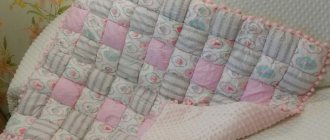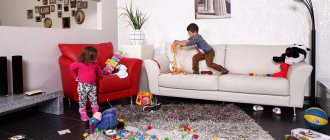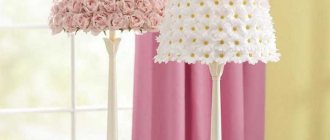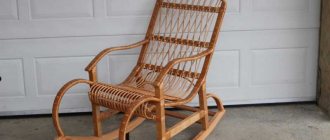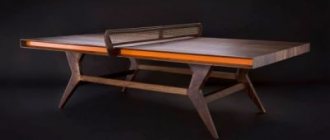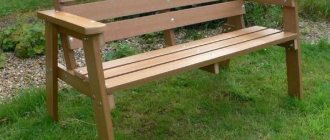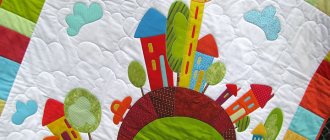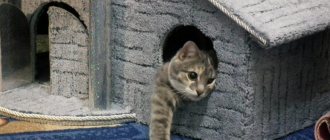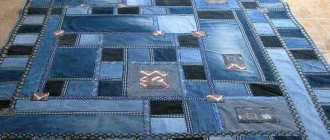A DIY bonbon blanket is easier than it sounds. No advanced sewing skills are required; to create this blanket you just need to sew fabric scraps together.
Bonbon is a type of patchwork. Many people use this technique today, as it is quite popular and simple. In addition, it allows you to achieve a variety of product design options with your own hands. Another advantage is the ability to sew a large and beautiful blanket from leftover fabrics in different colors, which are not suitable for most other sewing methods.
The bonbon blanket is perfect for a child's room, bedroom, living room. It all depends on the color and texture of the material used. By the way, you can sew not only a blanket using the simple bonbon technique. Covers for chairs and armchairs, decorative pillows and other interior items look great. In this article you will find a guide on how to sew a baby blanket.
What is it and what is it eaten with?
Initially, such a blanket was intended solely for decorative use. The patchwork technique in one form or another exists among almost all nations. "Bonbon" is a variation of this technique. At one time there was a catastrophic shortage of fabric, and every free scrap was used in the work. Therefore, the blankets turned out to be very colorful and varied in texture.
Bonbon is a type of patchwork technique.
Today this model has several names: “Bonbon”, “Biscuit”, “Marshmallow”, “pouf blanket” and the like. Since modern craftswomen have no shortage of materials, the blankets turn out to be very impressive and presentable. Even if the accessory is made from multi-colored fabrics, the palette is carefully selected. The technology for creating a Bonbon blanket is considered a type of decorative and applied art, and the result looks more textured and unusual compared to regular patchwork.
This blanket is made using the technique of stuffed patches.
This unusual blanket has two sides: the back side, which is more even (probably, it would be more accurate to say, flat), and the front side, consisting of square fragments of the same size. The edge of the blanket is decorated in different ways: it can be just a wide edging, or in addition to the edging, a lace braid or frill with small pompoms can be used.
In addition to the blanket, you can also sew bumpers on the crib.
How much does it cost and where to buy
The price range is quite large. A small blanket for children can be found for RUB 1,000, while a double blanket for adults can approach RUB 20,000. Buy from an online store or a regular one that sells bedding, the choice is yours. An individual design can be made by a craftsman to order. If you want, it’s easy to make a bonbon blanket yourself; you just need a little persistence.
Practical or just pretty?
The “Bonbon” blanket is not just a unique thing, but also a practical accessory. Such a model will easily become a spectacular accent of the interior, emphasizing the sense of style of its owners. Moreover, the blanket will reliably cover and warm you.
The blanket, sewn in the bonbon style, is warm and light.
The product is truly multifunctional:
- Can be used for its intended purpose as a blanket.
- Some people prefer to use this accessory as a blanket or bedspread.
- Depending on the size, it can easily cope with the role of a cover for a chair, armchair, or ottoman.
- It quickly transforms into a blanket-cocoon, reliably covering you in an armchair or on the sofa.
- For a children's room it can be used as a rug for a baby who has just learned to sit. Tiny ottomans will soften the fall.
It can also be used as a mattress for a baby. It will reliably protect the baby from impact when falling.
Design options
Bonbon is a technique that implies the presence of many options for color and texture combinations in one product. You can combine ottomans or pillows in contrasting shades, or, on the contrary, you can create calm combinations. Delicate floral designs and pastoral motifs are good for a bedroom, girl's room or living room with a classic interior. Chocolate and beige make a dynamic and at the same time traditional combination that creates warmth and comfort. Wine shades add chic to the atmosphere.
If you want to create something completely unusual, metallic textures, foil-like fabric, shiny satin and crepe-satin combined with matte details will come to the rescue.
Decorative and functional model option
If the blanket is not intended for use by small children, it can be decorated with a bright edging with rhinestones or sequins.
As for the arrangement of parts by color, it all depends on the choice of the master. He prepares a scheme of color combinations in advance, thinks through how and in what quantity to place squares in a horizontal row, and makes the overall appearance of the product attractive.
Mint or lemon in combination with gray, pink in combination with gold - the color scheme of bonbon blankets can attract attention, relax the eye, and create accents. Considering the volumetric design of the product, it is not only a convenient and functional item, but also takes up enough space in the space, so it is worth considering its appearance in advance.
The texture of the fabric can also serve as decoration
If we talk about the difference between children's and adult models, then lush-looking pillows are more appropriate for the play environment of a children's room. As for the choice of colors, all kinds of bright ottomans, juicy and eye-catching, are suitable for children. You can also opt for calmer pastel options. If the fabric has large prints with famous fairy tale and cartoon characters, you can use a pattern measuring 10 by 10 centimeters or more for the ottomans. Other large patterns that combine with each other are also suitable.
For adults, the decisive factor is the overall style of the room and color in combination with the color schemes of the product.
The size of the squares may vary
Advantages and disadvantages
Like any model, this blanket has its strengths and weaknesses. “Bonbons” are rightfully considered exclusive; they are not created en masse, which means that having such an accessory, you can rest assured that you have acquired a unique item of its kind. After all, even if your model was made by a needlewoman who made your neighbor happy with the same blanket, it will not be absolutely identical. And this is the beauty of hand-made.
The blanket has two sides - the wrong side (smoother) and the front side, consisting of stuffed squares.
And due to the fact that fabric of different colors can be used in the work, you can order (or sew yourself) a blanket with any pattern: from primitive diagonal stripes to some kind of ornament.
This blanket can be made monochromatic or multi-colored. It looks great both in a children's room and in an adult's bedroom.
Advantages:
- Thermal properties are not inferior to ordinary blankets. Reliably protect from cold and drafts.
- Thanks to the use of modern lightweight fillings, this unusual blanket is lightweight, so it can be used for both adults and children.
- Most are made from natural materials, and, as a result, are ideal even for allergy sufferers or very sensitive people.
- Large range of sizes available. Bonbon blankets are made for newborns, small children, teenagers, as well as for adults, and even for the elderly.
- The models feature a natural lining on the reverse side, which provides additional comfort while sleeping.
- There is always a choice: buy just a blanket or a complete set, which includes additional covers, as well as pillows, either made using the Bonbon technique, or regular models, but in the appropriate colors.
- Modern materials are used as filler, which are not only light in weight, but also resistant to the appearance of all kinds of microorganisms, and are also easy to clean.
- For blankets made using the bonbon technique, dense textiles are used that do not allow dust to pass through and do not contribute to the appearance of dust mites, which can cause redness and itching in a child (and even an adult).
- Such blankets are very mobile; if desired, they can be rolled up very tightly and stored in any drawer or niche where they will take up minimal space.
- Not only a professional craftsman, but also a novice needlewoman will be able to create her own masterpiece called “Bonbon”. The technique is quite simple (especially since there are accessible instructions), and at the same time interesting. So you can ensure yourself several unforgettable evenings doing what you love with a practical end result.
- This is a wonderful gift for loved ones. You will not only provide them with the necessary and beautiful thing, but also give them a piece of yourself.
- For the most part, Bonbon blankets are easy to care for; they can even be machine washed on a delicate cycle at a temperature not exceeding 30 degrees.
- Finally, such an unusual blanket will decorate any interior. In addition, “Bonbon” always looks stylish and expensive. So, even skeptics about hand-made are thinking about purchasing such an accessory.
A plain version of the marshmallow blanket.
Unfortunately, it was not without its shortcomings either. Although, these are rather not shortcomings in the full negative sense of the word, but rather features of the use of the blanket. For example, many are accustomed to using regular blankets as an addition to a mattress, increasing the softness of the latter. Bonbon is not suitable for this purpose, since the uneven surface of the blanket interferes with the correct position of the back. This is especially critical for infants and young children.
For small children, this version of the blanket cannot be used as a mattress.
The next nuance is the limited form options. Since the blanket is made from square elements, it can be either square or rectangular when finished. Also, restrictions relate to the size of the elements themselves: if you make the “ottomans” too large, the blanket will look rough and unattractive, and the design will become completely incomprehensible.
The shape of this blanket can be square or rectangular.
Another nuance concerns drying the blanket. After washing, you can't just hang it up and wait for it to dry. This model should only be dried in a horizontal position, avoiding the use of any heating devices or iron.
It is necessary to dry the “Marshmallow” in a horizontal position away from heating devices.
Making a blanket with the unusual name “Bonbon” will take time and perseverance, but the result will definitely please you. Such models fit very harmoniously into the “girly” interior of a nursery, but boys, most likely, are unlikely to appreciate the uniqueness of the model. Therefore, if your family does not have little princesses, but only growing knights, it is better to buy an ordinary blanket for them.
Any boy, even a teenager, will like this blanket.
What is required for production
Before you start sewing, you should make sure that you have all the materials and tools necessary for the work and place them within reach. If new fabric is used for sewing, it is recommended to pre-wash, dry and iron it to avoid shrinkage of the finished product.
Tools and materials:
- fabric for small “ottomans” (preferably soft and not thick);
- base material (chintz, satin or other cotton fabrics);
- filling for “ottomans” (sintepon or holofiber);
- threads to match the fabric;
- needles, pins;
- scissors, pencil, ruler;
- sewing machine.
It is not recommended to use cotton wool as a filler: in addition to the fact that the blanket will be heavy, difficulties will inevitably arise with washing the product (cotton wool tends to roll and flake).
Varieties
Blankets with ottomans are made in two types: for children and for adults. The difference between the models is in color, finish, and, of course, size.
For children's models, fabrics with cartoon prints or delicate colors (pink and white, mint, etc.) are used. Very often, blankets for children are produced as a set and are distinguished by a different texture for each product, for example, blankets made using the “Bonbon” technique, and pillows are figured, but made using conventional techniques and harmonizing in color with the blanket.
Set - bonbon blanket and pillows.
Blankets for adults are made in more subdued colors. If the material is not monochromatic, then it is a floral print or a discreet ornament. Although, in fairness, it is worth noting that there are no strict rules in choosing the color of the material.
Bonbon in an adult's bedroom looks no less cozy and original.
If you like bright colors, use them, just make sure that the interior is not too overloaded with multicolors.
Bonbon bedspreads for adults are made in more subdued colors.
Standard marshmallow blankets for adults are complemented by regular pillowcases made from pouffe textiles. In this case, the set turns out to be interesting and not “flashy”.
A soft and warm product can perform many functions and will be useful to every family member.
Selection and preparation of materials
The base of the blanket will be a simple piece of fabric. A regular sheet will do for this purpose, since it won’t be visible anyway. But it should be soft and pleasant to the touch, since it will constantly touch the body.
Note! Everyone chooses the fabric for the components of the blanket to their own taste. You can use both synthetic and natural materials. The color palette can also be varied. Some people prefer minimalism and one or two colors will be enough, while others will want to recreate all the colors of the rainbow.
Another color option
The padding must be of high quality and not crumple when washed. An excellent option would be synthetic winterizer. Cotton wool and its derivatives must not be used for stuffing. Such materials lose their appearance after the first wash, and they will also accumulate moisture inside the blanket.
Threads must be selected in accordance with the colors of the fabrics for the fragments. Each element must be sewn in its own color so that it does not stand out from the overall picture.
You will also need a small set of pins to temporarily secure the elements to the blanket, and a marker to mark the fabric.
How to sew a blanket yourself
Making a bonbon blanket with your own hands is not at all difficult. It's worth noting that there are at least two ways to create a spectacular Bonbon blanket.
Sewing such a blanket is not too difficult. Any beginning seamstress can handle it.
First way
It all starts with a diagram and pattern. On a separate sheet of paper, draw a diagram of your future masterpiece. The more detailed the diagram, the easier it will be to implement it. Carefully note not only the dimensions of the ottomans, but also the colors and the final design you want to achieve.
First, draw a diagram of the blanket and decide on the dimensions.
After this, we proceed to the main part of the work. We cut out squares of two sizes. For example, one with a side of 15 cm, and the other with a side of 21 cm. They are cleaved together in this way: to reduce the side of a larger square, folds are made. Their number can be from 2 to 4. Then three sides of the square are stitched, and the fourth is left for subsequent turning and stuffing with filler. Now they can be sewn together on a typewriter. Having made the required number of “ottomans”, they are customized onto the base fabric, and then the edge of the blanket is processed in any way convenient for you.
The squares are connected to each other and stitched.
Second way
This option is considered simpler in execution, only the blanket turns out to be monochromatic and not very embossed. The fabric on the front side is drawn into squares and stitched along the marked lines. Just remember to add folds in each square, otherwise you will end up with a regular quilt. Gauze is sewn to the wrong side. Then a hole is made in each purl gauze square, and the squares are filled with holofiber or padding polyester. After all the squares have been filled, the backing fabric is hemmed. At the final stage, the edge is processed.
In this case, the fabric is simply sewn into squares and stuffed with filler. The blanket turns out to be one color and not very embossed.
The "Bonbon" blanket is a stylish and functional thing. It will decorate your interior and will delight your loved ones if you decide to give them a handmade gift.
Bombon blanket patterns
The basis for successful and waste-free production is drawing up the right plan. The placement of the main elements can be anything. You will be able to implement interesting ideas, involve children in sewing, and create a playful and useful item for them. Using similar rules, you can make decorative children's cushions for sitting on the floor.
We offer several different diagrams that will help in calculations and understanding the principles of arrangement and sewing of bombon components. They will fully allow you to understand how best to assemble the pads, how much to retreat when stitching, etc.
Basic sewing techniques
To make a bonbon blanket, there are two main sewing techniques. In both cases, you can sew a blanket either on a sewing machine or by hand (if you don’t have one).
- The first method is to make a product from strips of squares, which are stitched one by one onto the base, and then stitched on three sides, forming pockets into which the filling is placed. At the final stage, the resulting ottomans are stitched on the fourth side.
- The second method is to connect small pre-prepared ottomans, which are then sewn onto the base according to a pre-approved pattern.
General sewing patterns for ribbon type
Cutting and fabric consumption
In order to choose the amount of fabric required for sewing a product, you first need to decide how fluffy it will be. Sewing technology is also taken into account when cutting. Let's look at an example.
If you plan to sew a baby blanket measuring 80 by 110 cm for a crib or stroller, the fabric consumption will be as follows:
Table 2. Required materials
| Name | Consumption |
| Plain fabric for ottomans or multi-colored fabric | Depends on the size of the squares and sewing technology, but there are a number of recommendations. If the structural basis is ribbons, then to the size of the square of the base fabric (where the outer ribbon part is attached) you need to add two or three centimeters on all sides and an additional 1 centimeter for the overlap (to cut out the front squares, cut out the base from thick cardboard and lay it on the fabric ). If we are talking about sewing a blanket from ready-made pillows, then the fabric consumption is also determined by their number and the side of the square. |
| Lining material | If a hem is used when sewing, then for the lining side you need a piece measuring 100 by 130-120 centimeters; when using edging, you need a piece of the same size as the final product - 80 by 110 centimeters. |
| Intermediate layer on which the pads are sewn | 80 by 110 cm fabric. |
| Kant | For the edging, you need to purchase a wide bias tape with a total length of 4 meters: (80 cm + 110 cm) * 2 = 4 m (here the length is indicated with a margin), or use a strip of fabric with a width of at least 5 centimeters, the length of such a strip - similar. |
| Holofiber for filling | 700 grams. |
Bright prints of blankets for children's rooms
If you use a frill element instead of a piping, you will need to recalculate the amount of fabric consumed when sewing. The length of the strip in this case will be 2-3 times longer than when using edging. It is also worth considering the desired splendor of the decor of the product.
Making a blanket from ribbons
Let's look at how a bonbon blanket is made in the first way - by assembling the product from ribbons. Let's also do this using the example of a blanket that can be placed in a child's bed. It serves as both decoration and insulation during the cold season. An additional function of a bonbon blanket for a child is educational. You can crawl on it, it is interesting to hide in it, but at the same time it is not heavy if it is made of fabric stuffed with modern insulation.
Finished blanket
Stage 1. Selecting materials for sewing a bonbon blanket
The size of the final product is 80 by 110 cm. This size is well suited for children's furniture.
At the first step, you will need to prepare pieces of fabric of different colors, as well as internal filler, which will create volume for the finished product.
You will need:
- 3 cotton colors for bombons;
- base for a blanket for the back side measuring 100 by 120 centimeters (if you need a blanket without edging, then for sewing take another piece of fabric for the back of the base with similar sides - the parts are sewn together, in the photo - the finished product processed in the second way);
- filler in quantity 700 grams.
Quality filler is an important factor
You also need threads, stationery for marking, pins, scissors, and a sewing machine.
You need to lay out the available cuts in front of you and choose the best combinations. For a child model, these can be discreet, gentle combinations, unlike the more contrasting ones for adults. Bright colors can be a good choice for children whose activity needs to be stimulated by bright accents in the interior.
It is better to take dense calico as a basis.
For the base you need to choose dense natural and high-quality fabric
For the inside of the bonbon blanket, which will touch the body, you should use natural fabrics.
Front side materials can be of any color
Decorative materials (ribbons, lace elements, stickers, stripes, etc.) can also be useful from raw materials. At the same time, when sewing a baby blanket, you should always remember the safety of the parts. You should avoid elements that can easily come off or injure a child (rhinestones, sequins, etc.).
The product can be decorated in different ways
For sewing, you should take scissors, an iron, pins to secure the fabric, sewing thread, materials for making notes (pencil, chalk, soap). For cutting, you will need paper on which the canvas plan will be drawn.
Stage two. Sketch development
At the next step, the master must transfer the plan of the future bonbon blanket onto paper. It would be nice if the diagram reflected the design of the pattern. In this case, you get 80 squares measuring 11 cm (the blanket consists of 8 squares in width and 10 in length).
The paper will help you visualize the pattern of the blanket
The base fabric can have any color, since sewn pillows filled with padding polyester or holofiber will be placed on top of it. This option comes in three cotton colors.
If you want to make a product of a different size according to this pattern, you need to think about it in advance. It is calculated based on the wishes for the size of the pads. In the children's version, the component parts can have, in particular, dimensions of 6 by 6 cm. Dividing the final length and width of the product by similar indicators of the component pads, we obtain the total number of parts. Or, on the contrary, we add up the overall picture from the sizes of the parts.
At the same stage, the fabric for the base is drawn out for the patch of ottoman parts. It is lined into squares with a side of 11 cm, leaving one centimeter for allowances.
Markings are made directly on the fabric
We must remember that in addition to the squares themselves and the distance between them, the pattern must contain 6 centimeters for allowances (another option is allowances of up to 5 centimeters, but not less than three), folds, and piping to decorate the finished product.
Stage three. Preparing the external components of the bonbon blanket
Squares of fabric, cut from sections, are sewn to each other “with a train” so that a ribbon is formed (the stitching is machine-made). Next, the seams between the parts are ironed to the right side. The next ribbon is assembled from squares, stitched, but the seams are ironed to the left, etc. This alternation allows you to achieve a beautiful connection of the ribbons with each other.
The parts are sewn together with ribbons
Next, the resulting ribbons are pinned to the base using “invisible” tapes, forming folds. It is very important to be careful at this step. The appearance of the finished bonbon blanket for a child depends on this.
Sewing is done in a strictly established order
First sew the top of the squares for ottomans along a horizontal line, and then the side seams - in full accordance with what is drawn on the base.
Important. The bottom of the squares is cleaved with the base at the place where the seam allowance strip ends, not the square.
Form folds
Folds can be made in different ways. You can do them inward or in different directions.
The sides are sewn strictly along the seam between the tape parts.
The product must be stitched strictly along the seam
After the so-called “pockets” have been created, they are stuffed with filler (the ottomans should be of medium density) and then the lower part of the tape is attached to the base fabric.
Rows form one after another
The next row is drawn up in the same way until the entire working space of the base is filled. To sew on the next strip, you first need to gather it into folds and then sew it to the first with right sides. You should carefully carry out this operation, getting into the seam lines.
The base consists of rows
At the final stage, you will need to fold the front sides and lining material. They are stitched together along the contour of the ottomans. In order to be able to turn the blanket inside out, leave a 25 cm incision. After this is done, the product is sewn to the end using a hidden seam.
To ensure that sewing requires a minimum number of operations, you can attach the next strip, covering the previous cut site where the soft filler is placed. To sew a blanket in this way, at each stage they make sure that it does not “float”, strengthening the rows with pins or needles.
After all the tapes are in place and the product is ready, the final processing consists of sewing piping on the sides, or stitching the base and bottom layer. Finally, all that remains is to steam the back side, and it is ready for use. You can also decorate the product with satin ribbons.
Recommendation. If you sew an additional layer of padding polyester from the inside out, under such a blanket it will become even more comfortable and warmer.
Blanket made from ready-made “bubbles”
A bonbon blanket can be made up of pillows sewn together.
The set of tools and materials is the same. With the difference that the number of squares should be doubled. A bright fabric is used on the front side, and any other fabric on the back side (it won’t be visible anyway).
Step 1. Forming strips of pads
First, three edges are sewn on each component strip, then filler is placed in the pad and closed with a fourth seam. The same should be done with all pillows, the number of which is determined by the size of the final product.
Pillows are sewn separately
When the blanks are completed, they are connected into strips. It is important that they are smooth and do not create distortions. When stitching, corner should meet corner. It is advisable to first make a basting, and then go through the main seam.
Step 2. Obtaining a fabric from strips
Once there are enough stripes for the blanket, the lines are collected into a large canvas. The base is additionally stitched. The alternation of colors and the number of parts in length and width are thought out in advance.
Assembly
Step 3. The pillows are “planted” on the base , which can be additionally insulated with several layers of padding polyester. Any natural dense fabric can be used as a base. Also, the perimeter of the base fabric can be decorated with frills, borders, etc.
Forming the Foundation
Step 4. Both parts are connected . The result is a comfortable blanket that can also be very warm.
Finished product
Step-by-step making of a baby blanket Bubblle Quilt
Let's look at the process step by step:
- We cut out squares of the required size from the front fabric and the lining fabric (base). The details of the back side of the bonbon blanket are cut 2 cm smaller on all sides. It is necessary to make cuts on the bottom squares for stuffing the product. To do this, the part is folded diagonally and cut into 4–5 cm with scissors.
- Both parts are pinned together; for volume, folds are placed on opposite sides of the front parts. Sew along the entire perimeter with a seam width of 0.5 cm. The pins are removed and the resulting “double squares” with folds are sewn together with a seam of 0.7–1.0 cm in stripes. The ends of the seams are secured.
- When they begin to connect strips of square parts, the seams of adjacent parts are laid out in different directions. The strips are fastened with pins at the seam areas and stitched with a centimeter seam.
- Let's start stuffing the bonbon's poufs through the left holes. After the insulation is stuffed, the incisions are sewn up by hand.
- The fabric and rolled insulation (sintepon) are cut out according to the size of the assembled product. The insulation is fastened to the fabric with a machine seam (0.5 cm) or quilted.
- Fabric with insulation and a piece of stuffed squares are fastened to each other. The edges of the bonbon are edged.
You can make this way not only a blanket, but also bonbon bumpers for a baby crib. In this case, you will need tapes that will attach the sides to the baby's crib. For one part of the side you need 5 tapes of 70 cm each. Two folded ribbons are sewn along the edges and one in the center. The ribbons are then cut in half to tie the bonbon on the crib with a beautiful bow.
How to fill a bonbon blanket
It is better to choose lightweight synthetic materials from fillers, for example, holofiber or padding polyester. They do not bunch up during washing and do not accumulate moisture. Sometimes batting is used for blankets, which warms well, but has more disadvantages, including weight, the ability to retain moisture and accumulate it inside the blanket. After washing a blanket with such a filling, the cotton wool will begin to clump together, and the thing itself will lose its original appearance. Before choosing the type of filler, you need to think about what the final weight of the blanket will be.
Beautiful interiors with a bomb blanket
Features of combining beds with carriage frames with interior styles
Since a textured “biscuit” style blanket is unique in itself and immediately attracts attention, it is preferable to make some connection to existing interior items
The style can be expressed through the print of bombons, their shades, special elements (for example, bears, suns indicate a children's theme and the young age of the user). Styles for older children are made with a less bright print, but the emphasis is on color: for example, it can be repeated in the tone of curtains, wallpaper, table lamp shade, flower pot, painting design.
You should not be overzealous with one color, flooding the entire area of the room with it: an excess of color negatively affects the design idea, creating a depressing atmosphere.
To make the blanket look beautiful in the interior, we must not forget about the size of the squares. Small ones are universal and fit perfectly into the overall picture; large ones create the illusion of decorative pillows laid in rows.
This blanket looks beautiful in a variety of styles. The most typical design option is country (if the model consists of bright colors). To fit a product into classic or modern style, you will need to make it monochromatic without additional decor.
The Arabic version is also possible: gold trim, a slight repetition of the color combination of the room, a maximum of two colors - and the blanket from “A Thousand and One Nights” is ready!
If you want to show luxury, you should choose expensive textiles with companions (one unloading monochromatic, connecting the other two with a pattern). Every little detail matters: the print should be premium, lace, but not colorful.
Bonbon blanket patterns and sizes
It’s worth deciding in advance on the sizes for an adult and a child’s bedspread:
- For newborns and preschool children, models with sizes from 70-120x100-140 cm are suitable.
- It is better for teenagers to choose the middle option – 80-120×180-190 cm.
- For adults, the ideal choice would be models with dimensions of 140-180×190-200 cm.
The dimensions of standard pillows for children's blankets are 11x11 cm, for adults 6x6 cm. Below are patterns designed for sewing a children's model with sides of 120x60 cm.
It is better to draw a design diagram for the future blanket in advance. In the process of cutting the fabric, adhere to the specified dimensions. Ready-made squares with filling are tightly attached to each other.
